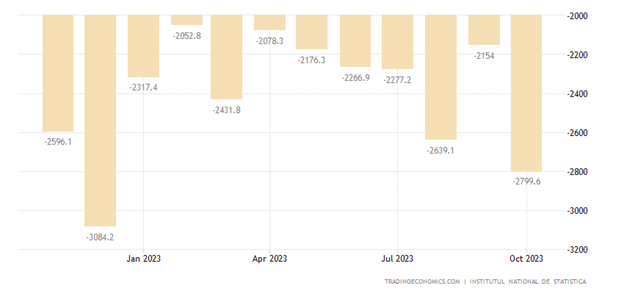
Recent economic events in 2023 also determine the trend for 2024. Romania’s economic growth forecasts for 2024 range from 2.5% to 3.4%, with the Romanian government having the most optimistic expectations. A super election year awaits us with four rounds of elections – European, local, parliamentary and presidential. Each of these election rounds could affect economic stability if populist promises prevail over economic logic.
It seems that Romania has not learned much from previous crises, as pro-cyclical economic policies are the ones that put our country in a difficult position.
Budget expenditures in 2024 will amount to approx. According to the Ministry of Finance, it is 48 billion lei more than in 2023. According to the most optimistic scenario, revenues will increase by 47 billion lei compared to this year. But it is clear that Romania has little chance of reaching the 3% target, according to the Maastricht Treaty.
According to the criteria of the Maastricht Treaty, for joining the Eurozone, the budget deficit should not exceed 3% of gross domestic product (GDP), and the total public debt should not exceed 60% of GDP.
In 2023, Romania was the only EU country in the excessive deficit procedure, and in 2024 the situation may become even more difficult. Romania ended 2023 with a deficit of more than 5% of GDP, well above the projected target of 4.4%. It should be noted that Romania has been in the excessive deficit procedure since 2020.
It is difficult to predict the figure for 2024, but with certainty Romania’s trajectory will be tortuous: from almost 10% in 2020 to 6.7% in 2021 and 5.7% in 2022, ie approx. 5-5.5% in 2023 and possibly a drop to 6% in 2024.
In absolute terms, the total deficit of the consolidated budget increased to 3.97% of GDP after the first 10 months of the current year, i.e. to 62.81 billion lei, compared to the deficit of 47.12 billion lei (3.34% of GDP), which refers to the first 10 months. months of 2022. This means a real growth of almost 50% in one year.
Romania has consistently failed to follow a disciplined fiscal policy, and decision-makers have consistently fallen into the trap of keeping public spending high. During periods of economic growth, we have seen increases in government spending followed by increases in fees and taxes to balance the budget.
The most striking example is that in 2008 economic growth was a record 8.5%, while the budget deficit also recorded a record value of 5.1%. In 2009, Romania ignored the signs of the financial crisis that appeared in the EU and North America and entered this crisis unprepared and later than other countries. Lack of discipline and vision to implement countercyclical economic measures caused Romania’s sharp economic decline of 7.1%.
The consequences of the crisis were not mitigated by preventive measures, and even after the onset of the crisis, no real corrective measures were taken, other than measures to reduce public spending. But these measures were not uniform across the public spending sector. Lack of balance and pro-cyclical fiscal and budgetary policies were aggravating factors. The social consequences were devastating, especially after a 25% cut in public sector wages and an increase in the VAT rate to 24%. Thus, Romania found itself in a situation of turning to financial institutions for financial stabilization.
As a result of the financial crisis that began in 2008, Romania signed an agreement with the International Monetary Fund, which was completed in 2013. In 2014 and 2015, the budget deficit was under control. In 2015, Romania was the closest to anti-cyclical fiscal policy: GDP grew by 4% and the budget deficit was only 0.6%. However, between 2016 and 2018, Romania missed a great opportunity to have a countercyclical fiscal policy. Thus, from 2016 to 2018, the budget deficit increased to 3%, and GDP grew every year at a rate of 4.5% to 7.1%.
If we look at the last 17 years since Romania joined the European Union, we will notice that fiscal discipline was only when our country had an agreement with the International Monetary Fund. Due to the rejection of this agreement, the budget deficit increased to the maximum level provided for by European legislation (3% of GDP).
Looking at the trade deficit, its value remained high and was approx. 28 billion euros in the first ten months of 2023:

Although the trade balance deficit decreased by more than 18% in the first 10 months of last year, it remains high. According to forecasts, in 2023, Romania will record a trade deficit of more than 33 billion euros. Despite the deficit reduction, Romania remained in the weakest position in the region.
Romania had relatively low export growth rates (+2%). The value is lower than in Slovakia (+7%), Hungary (+5%), the Czech Republic and Poland (both +4%), but better compared to the significant reduction in Croatia (-5%) or Bulgaria (-8%). Romania has maintained an external imbalance that remains worrying, especially against the background of a significant decline in industrial production (-5.1% after 9 months), a sharp drop in October (-2.3% compared to October 2022).
The economic threats of 2024 begin with excessive deficits, compounded by the risks of a super-election year. _ Read the rest of the article on Contributors.ro
Source: Hot News
James Springer is a renowned author and opinion writer, known for his bold and thought-provoking articles on a wide range of topics. He currently works as a writer at 247 news reel, where he uses his unique voice and sharp wit to offer fresh perspectives on current events. His articles are widely read and shared and has earned him a reputation as a talented and insightful writer.